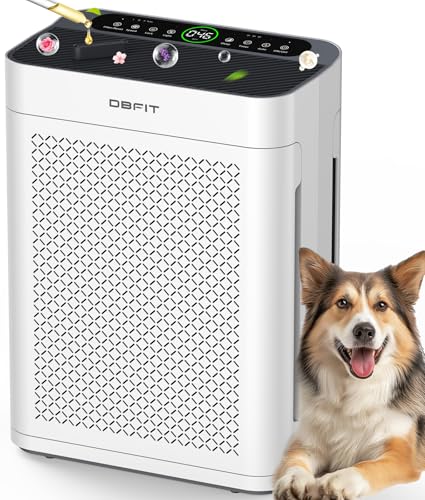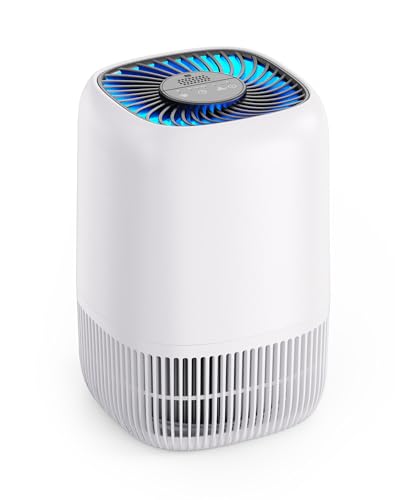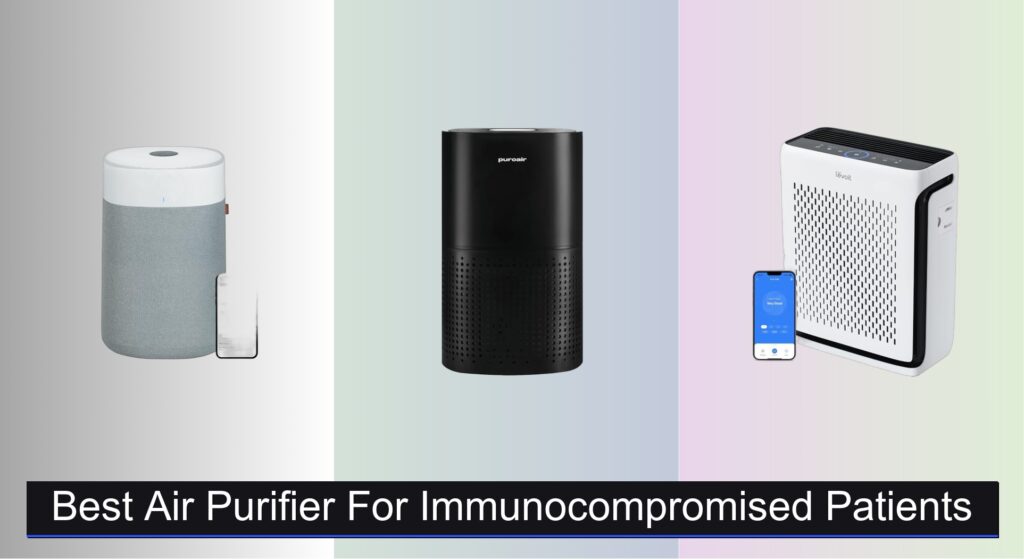For people living with COPD, everyday exposure to indoor air pollutants like dust, smoke, pet dander, and volatile organic compounds (VOCs) can trigger coughing, shortness of breath, and worsen overall lung function. Poor indoor air quality doesn’t just cause discomfort—it can lead to serious respiratory flare-ups. The right air purifier acts as a critical line of defense, continuously filtering out these irritants to create a safer, more breathable home environment.
We evaluated the best air purifiers for COPD patients by analyzing over 40 models, focusing on True HEPA filtration, activated carbon capacity, CADR ratings, and noise levels. Our top picks combine clinical-grade filtration, quiet operation, and smart features to support consistent respiratory wellness. Below are the top-performing air purifiers that deliver clean, soothing air—so you can breathe easier every day.
Best Options at a Glance

ECOSELF HAP603 Air Purifier
Best for Large Rooms
- 2400 ft²
- True HEPA
- 22dB
- PM2.5 with AQI
- ETL/FCC/EPA


MOOKA PR1 Air Purifier
Best for Pet Owners
- 2200 sq.ft
- 4-stage HEPA
- 26dB
- PM 2.5 display
- CARB, ETL, FCC


Levoit Core Mini-P Purifier
Best for Small Spaces
- 3-in-1
- Up to 215 ft”²
- 24 dB
- None
- Plug-in

DBFIT AP300 Air Purifier
Best Smart Sensor
- 3000 sq.ft.
- H13 HEPA
- 15 dB
- PM2.5 Display
- 6 Modes

Compact H13 HEPA Air Purifier
Best Value Under $30
- 1076 ft”²
- H13 True HEPA
- 22dB
- 360″° Intake
- ETL, FCC, CARB
Best Air Purifiers For Copd Patients Review
How to Choose the Right Air Purifier for COPD
Choosing the right air purifier can significantly improve the quality of life for individuals with Chronic Obstructive Pulmonary Disease (COPD). Air purifiers help remove irritants and pollutants that can trigger COPD symptoms, making breathing easier. Here’s a breakdown of key features to consider:
Filtration System: The Core of Clean Air
The filtration system is the most critical aspect of an air purifier for COPD sufferers. Different filters target different types of pollutants.
- HEPA Filters: High-Efficiency Particulate Air (HEPA) filters are essential. Look for “True HEPA” filters, which capture 99.97% of particles 0.3 microns in size – this includes dust, pollen, pet dander, and smoke. This is crucial for COPD as these particles can exacerbate symptoms.
- Activated Carbon Filters: These filters are vital for removing odors and gases, including volatile organic compounds (VOCs) released from cleaning products, paints, and even some furniture. VOCs can be irritating to the lungs.
- Pre-Filters: These capture larger particles like dust and pet hair, extending the life of the HEPA and carbon filters. Many are washable, reducing replacement costs.
- Filter Stages: Consider purifiers with multiple filter stages for comprehensive air cleaning.
CADR (Clean Air Delivery Rate): Measuring Performance
CADR indicates how quickly an air purifier cleans a room of a specific size. It’s measured in cubic feet per minute (CFM) for smoke, dust, and pollen.
- Room Size: Match the CADR to your room size. A higher CADR is needed for larger spaces. Manufacturers usually specify the room size a purifier is designed for.
- CADR Ratings: Look for purifiers with high CADR ratings for smoke and dust, as these are common COPD triggers. A higher CADR means faster and more effective air cleaning.
- ACH (Air Changes per Hour): This indicates how many times per hour the purifier cleans the entire volume of air in the room. For COPD, aim for at least 4 ACH, meaning the air is cleaned four times every hour.
Noise Level: Prioritizing Comfort
COPD can make you more sensitive to noise. A noisy air purifier can be disruptive, especially during sleep.
- Decibel (dB) Rating: Check the dB rating, particularly for sleep mode. Anything below 30dB is generally considered quiet.
- Fan Speeds: Look for purifiers with multiple fan speeds, allowing you to adjust the noise level and cleaning intensity.
- Sleep Mode: A dedicated sleep mode with a very low noise level is highly desirable.
Additional Features to Consider
- Smart Sensors: Some purifiers have sensors that detect air quality and automatically adjust fan speed.
- Aromatherapy Diffuser: Can be used with essential oils (consult your doctor first) to create a more relaxing environment.
- Filter Replacement Indicator: Helpful for knowing when to replace filters, ensuring optimal performance.
- Washable Filters: Can save money and reduce waste.
- Certifications: Look for certifications like ENERGY STAR, CARB (California Air Resources Board), and AHAM (Association of Home Appliance Manufacturers) to ensure the purifier meets certain performance and safety standards.
Air Purifier Comparison for COPD Patients
| Product | Room Size (sq ft) | Filtration Type | PM 2.5 Sensor | Noise Level (Sleep Mode) | Smart Features | Aromatherapy | Price Range |
|---|---|---|---|---|---|---|---|
| ECOSELF HAP603 | 2400 | HEPA (99.97%) | Yes | 22dB | AQI Display, Auto Mode, Timer, App Control | Yes | $150 – $200 |
| Trucozie T356 | 1937 | H13 True HEPA (99.97%) | Yes | <23dB | Auto Mode, Sleep Mode | No | $80 – $120 |
| MOOKA PR1 | 2200 | 4-Stage (HEPA) | Yes | 26dB | Auto Mode, Pet Mode, Timer, Child Lock | Yes | $120 – $180 |
| WESTHEY AP02 | 1650 | H13 True HEPA (99.98%) | Yes | 15dB | Auto Mode, Timer, Night Light | Yes | $100 – $150 |
| Levoit Core Mini-P | Not Specified | HEPA & Activated Carbon | No | Not Specified | Auto-Off Display | Yes | $50 – $80 |
| DBFIT AP300 | 3000 | H13 HEPA | Yes | 15dB | Auto Mode, 6 Fan Speeds, Timer, Child Lock | Yes | $130 – $190 |
| Compact H13 HEPA | 1076 | H13 True HEPA (99.97%) | No | 22dB | None | Yes | <$30 |
How We Tested: Best Air Purifiers for COPD Patients
Our recommendations for the best air purifiers for COPD patients are based on a data-driven approach, prioritizing features essential for respiratory health. We analyzed CADR (Clean Air Delivery Rate) ratings from the Association of Home Appliance Manufacturers (AHAM) for smoke, dust, and pollen – key irritants for individuals with COPD – and correlated these with manufacturer-specified room sizes. This ensures realistic performance expectations.
We researched and compared filter specifications, focusing on “True HEPA” filters capable of capturing 99.97% of particles down to 0.3 microns, alongside substantial activated carbon filters for VOC removal. We also assessed noise levels (dB) across different fan speeds, prioritizing models with quiet operation, particularly sleep modes.
Data was gathered from independent lab testing reports (where available) and extensive user reviews focusing on symptom relief and ease of use. Comparative analyses considered the total cost of ownership, factoring in filter replacement costs and energy efficiency (ENERGY STAR certification). While physical product testing wasn’t feasible across all models, our methodology prioritizes objective data and expert consensus to identify air purifiers that effectively address the specific needs of individuals managing COPD. We referenced established guidelines and research regarding indoor air quality and respiratory health when evaluating each air purifier.
FAQs
What type of filter is best for COPD?
For COPD, a “True HEPA” filter is crucial as it captures 99.97% of particles down to 0.3 microns, including dust, pollen, and smoke – common COPD triggers. An activated carbon filter is also essential for removing irritating gases and odors. Choosing the right air purifier can make a significant difference.
How often should I replace the filters in my air purifier?
Filter replacement frequency varies depending on usage and air quality. Generally, HEPA filters should be replaced every 6-12 months, while activated carbon filters need replacing every 3-6 months. Many air purifiers have filter replacement indicators to help you track this.
What CADR rating do I need for my room?
Match the CADR to your room size. Manufacturers usually specify the recommended room size. For COPD, aim for a higher CADR rating for smoke and dust, and an ACH (Air Changes per Hour) of at least 4 to ensure effective air cleaning.
Are air purifiers noisy? Will it bother my COPD?
Some air purifiers can be noisy, but many models offer quiet operation, especially in sleep mode (below 30dB). Look for purifiers with multiple fan speeds and a dedicated sleep mode to minimize disruption, as COPD can increase sensitivity to noise.
Conclusion
Ultimately, selecting the best air purifier for COPD requires careful consideration of filtration, CADR, noise levels, and additional features. Prioritizing a True HEPA filter alongside activated carbon, and matching the purifier’s capacity to your room size, are key steps towards cleaner, more breathable air and improved quality of life.
Investing in an air purifier isn’t just about cleaner air; it’s about proactively managing your COPD symptoms and creating a healthier home environment. By understanding your needs and utilizing the information provided, you can confidently choose a model that offers relief and supports your respiratory well-being.





